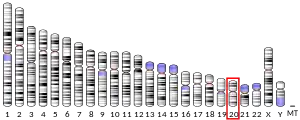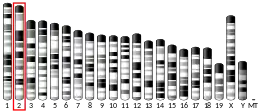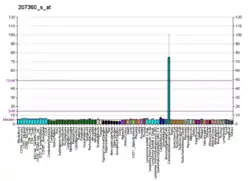Neurotensin receptor 1
Neurotensin receptor type 1 is a protein that in humans is encoded by the NTSR1 gene.[5][6] For a crystal structure of NTS1, see pdb code 4GRV. In addition, high-resolution crystal structures have been determined in complex with the peptide full agonist NTS8-13, the non-peptide full agonist SRI-9829, the partial agonist RTI-3a, and the antagonists / inverse agonists SR48692 and SR142948A, as well as in the ligand-free apo state.[7], see PDB codes 6YVR (NTSR1-H4X:NTS8–13), 6Z4V (NTSR1-H4bmX:NTS8–13), 6Z8N (NTSR1-H4X:SRI-9829), 6ZA8 (NTSR1-H4X:RTI-3a), 6Z4S (NTSR1-H4bmX:SR48692), 6ZIN (NTSR1-H4X:SR48692), 6Z4Q (NTSR1-H4X: SR142948A), and 6Z66 (apo NTSR1-H4X).
Function
Neurotensin receptor 1, also called NTR1, belongs to the large superfamily of G-protein coupled receptors and is considered a class-A GPCR. NTSR1 mediates multiple biological processes through modulation by neurotensin, such as low blood pressure, high blood sugar, low body temperature, antinociception, anti-neuronal damage [8] and regulation of intestinal motility and secretion.[6]
Ligands
- ML314 – β-arrestin biased agonist[9]
- Neurotensin (NT1)
See also
References
- GRCh38: Ensembl release 89: ENSG00000101188 - Ensembl, May 2017
- GRCm38: Ensembl release 89: ENSMUSG00000027568 - Ensembl, May 2017
- "Human PubMed Reference:". National Center for Biotechnology Information, U.S. National Library of Medicine.
- "Mouse PubMed Reference:". National Center for Biotechnology Information, U.S. National Library of Medicine.
- Laurent P, Clerc P, Mattei MG, Forgez P, Dumont X, Ferrara P, Caput D, Rostene W (May 1994). "Chromosomal localization of mouse and human neurotensin receptor genes". Mammalian Genome. 5 (5): 303–6. doi:10.1007/BF00389545. PMID 8075503. S2CID 30418560.
- "Entrez Gene: NTSR1 neurotensin receptor 1 (high affinity)".
- Deluigi M, Klipp A, Klenk C, Merklinger L, Eberle SA, Morstein L, Heine P, Mittl PR, Ernst P, Kamenecka TM, He Y, Vacca S, Egloff P, Honegger A, Plückthun A (January 2021). "Complexes of the neurotensin receptor 1 with small-molecule ligands reveal structural determinants of full, partial, and inverse agonism". Science Advances. 7 (5): eabe5504. Bibcode:2021SciA....7.5504D. doi:10.1126/sciadv.abe5504. PMC 7840143. PMID 33571132.
- Liu Q, Hazan A, Grinman E, et al. (2017). "Pharmacological activation of the neurotensin receptor 1 abrogates the methamphetamine-induced striatal apoptosis in the mouse brain". Brain Research. 1659: 148–155. doi:10.1016/j.brainres.2017.01.029. PMID 28130052. S2CID 6405660.
- Peddibhotla S, Hedrick MP, Hershberger P, et al. (2013). "Discovery of ML314, a Brain Penetrant Non-Peptidic β-Arrestin Biased Agonist of the Neurotensin NTR1 Receptor". ACS Med Chem Lett. 4 (9): 846–851. doi:10.1021/ml400176n. PMC 3940307. PMID 24611085.
Further reading
- Vincent JP (Oct 1995). "Neurotensin receptors: binding properties, transduction pathways, and structure". Cellular and Molecular Neurobiology. 15 (5): 501–12. doi:10.1007/BF02071313. PMID 8719037. S2CID 13335185.
- Vincent JP, Mazella J, Kitabgi P (Jul 1999). "Neurotensin and neurotensin receptors". Trends in Pharmacological Sciences. 20 (7): 302–9. doi:10.1016/S0165-6147(99)01357-7. PMID 10390649.
- Vita N, Laurent P, Lefort S, Chalon P, Dumont X, Kaghad M, Gully D, Le Fur G, Ferrara P, Caput D (Feb 1993). "Cloning and expression of a complementary DNA encoding a high affinity human neurotensin receptor". FEBS Letters. 317 (1–2): 139–42. doi:10.1016/0014-5793(93)81509-X. PMID 8381365. S2CID 5929592.
- Le F, Groshan K, Zeng XP, Richelson E (Jan 1997). "Characterization of the genomic structure, promoter region, and a tetranucleotide repeat polymorphism of the human neurotensin receptor gene". The Journal of Biological Chemistry. 272 (2): 1315–22. doi:10.1074/jbc.272.2.1315. PMID 8995438.
- Boudin H, Pélaprat D, Rostène W, Pickel VM, Beaudet A (Oct 1998). "Correlative ultrastructural distribution of neurotensin receptor proteins and binding sites in the rat substantia nigra". The Journal of Neuroscience. 18 (20): 8473–84. doi:10.1523/JNEUROSCI.18-20-08473.1998. PMC 6792847. PMID 9763490.
- Ye X, Mehlen P, Rabizadeh S, VanArsdale T, Zhang H, Shin H, Wang JJ, Leo E, Zapata J, Hauser CA, Reed JC, Bredesen DE (Oct 1999). "TRAF family proteins interact with the common neurotrophin receptor and modulate apoptosis induction". The Journal of Biological Chemistry. 274 (42): 30202–8. doi:10.1074/jbc.274.42.30202. PMID 10514511.
- Wang L, Friess H, Zhu Z, Graber H, Zimmermann A, Korc M, Reubi JC, Büchler MW (Feb 2000). "Neurotensin receptor-1 mRNA analysis in normal pancreas and pancreatic disease". Clinical Cancer Research. 6 (2): 566–71. PMID 10690540.
- Cusack B, Jansen K, McCormick DJ, Chou T, Pang Y, Richelson E (Sep 2000). "A single amino acid of the human and rat neurotensin receptors (subtype 1) determining the pharmacological profile of a species-selective neurotensin agonist". Biochemical Pharmacology. 60 (6): 793–801. doi:10.1016/S0006-2952(00)00409-3. PMID 10930533.
- Oakley RH, Laporte SA, Holt JA, Barak LS, Caron MG (Jun 2001). "Molecular determinants underlying the formation of stable intracellular G protein-coupled receptor-beta-arrestin complexes after receptor endocytosis*". The Journal of Biological Chemistry. 276 (22): 19452–60. doi:10.1074/jbc.M101450200. PMID 11279203.
- Leplatois P, Josse A, Guillemot M, Febvre M, Vita N, Ferrara P, Loison G (Sep 2001). "Neurotensin induces mating in Saccharomyces cerevisiae cells that express human neurotensin receptor type 1 in place of the endogenous pheromone receptor". European Journal of Biochemistry. 268 (18): 4860–7. doi:10.1046/j.0014-2956.2001.02407.x. PMID 11559354.
- Lundquist JT, Büllesbach EE, Golden PL, Dix TA (Feb 2002). "Topography of the neurotensin (NT)(8-9) binding site of human NT receptor-1 probed with NT(8-13) analogs". The Journal of Peptide Research. 59 (2): 55–61. doi:10.1046/j.1397-002x.2001.10946.x. PMID 11906607.
- Somaï S, Gompel A, Rostène W, Forgez P (Jul 2002). "Neurotensin counteracts apoptosis in breast cancer cells". Biochemical and Biophysical Research Communications. 295 (2): 482–8. doi:10.1016/S0006-291X(02)00703-9. PMID 12150975.
- Martin S, Navarro V, Vincent JP, Mazella J (Oct 2002). "Neurotensin receptor-1 and -3 complex modulates the cellular signaling of neurotensin in the HT29 cell line". Gastroenterology. 123 (4): 1135–43. doi:10.1053/gast.2002.36000. PMID 12360476.
- Toy-Miou-Leong M, Cortes CL, Beaudet A, Rostène W, Forgez P (Mar 2004). "Receptor trafficking via the perinuclear recycling compartment accompanied by cell division is necessary for permanent neurotensin cell sensitization and leads to chronic mitogen-activated protein kinase activation". The Journal of Biological Chemistry. 279 (13): 12636–46. doi:10.1074/jbc.M303384200. PMID 14699144.
- Magazin M, Poszepczynska-Guigné E, Bagot M, Boumsell L, Pruvost C, Chalon P, Culouscou JM, Ferrara P, Bensussan A (Jan 2004). "Sezary syndrome cells unlike normal circulating T lymphocytes fail to migrate following engagement of NT1 receptor". The Journal of Investigative Dermatology. 122 (1): 111–8. doi:10.1046/j.0022-202X.2003.22131.x. PMID 14962098.
- Brun P, Mastrotto C, Beggiao E, Stefani A, Barzon L, Sturniolo GC, Palù G, Castagliuolo I (Apr 2005). "Neuropeptide neurotensin stimulates intestinal wound healing following chronic intestinal inflammation". American Journal of Physiology. Gastrointestinal and Liver Physiology. 288 (4): G621–9. doi:10.1152/ajpgi.00140.2004. PMID 15764810.
External links
- "Neurotensin Receptors: NTS1". IUPHAR Database of Receptors and Ion Channels. International Union of Basic and Clinical Pharmacology.
This article incorporates text from the United States National Library of Medicine, which is in the public domain.




